
November 13, 2025
what is revision rhinoplasty surgery: candidacy & recovery
what is revision rhinoplasty surgery? Learn who qualifies, what to expect during recovery, and tips for choosing a skilled, trusted surgeon.
Nov 13, 2025
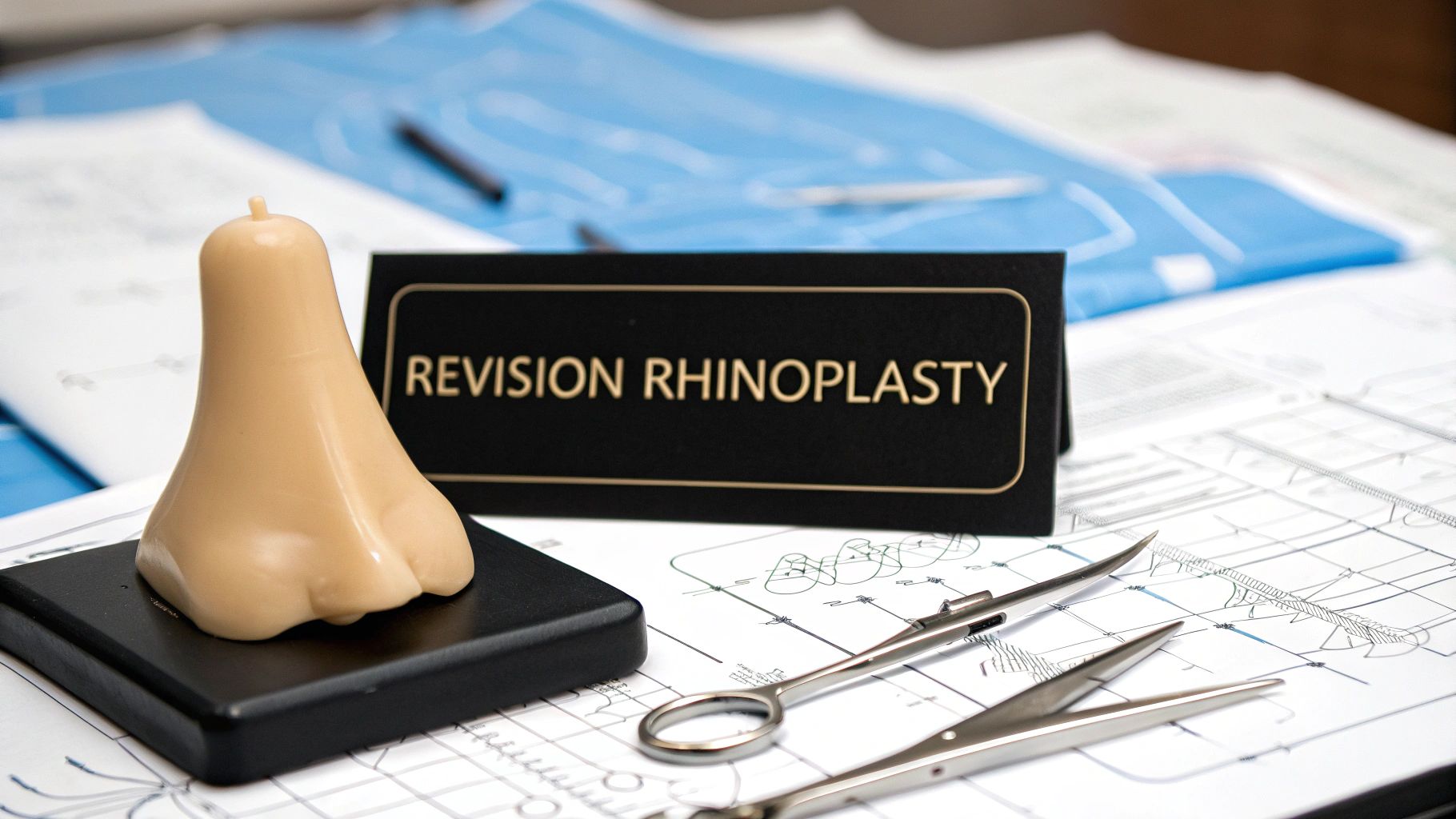
Revision rhinoplasty surgery is a corrective procedure meant to improve on the results from a previous nose job. It's designed to fix both aesthetic issues and functional problems, like breathing difficulties, that weren't resolved the first time around.
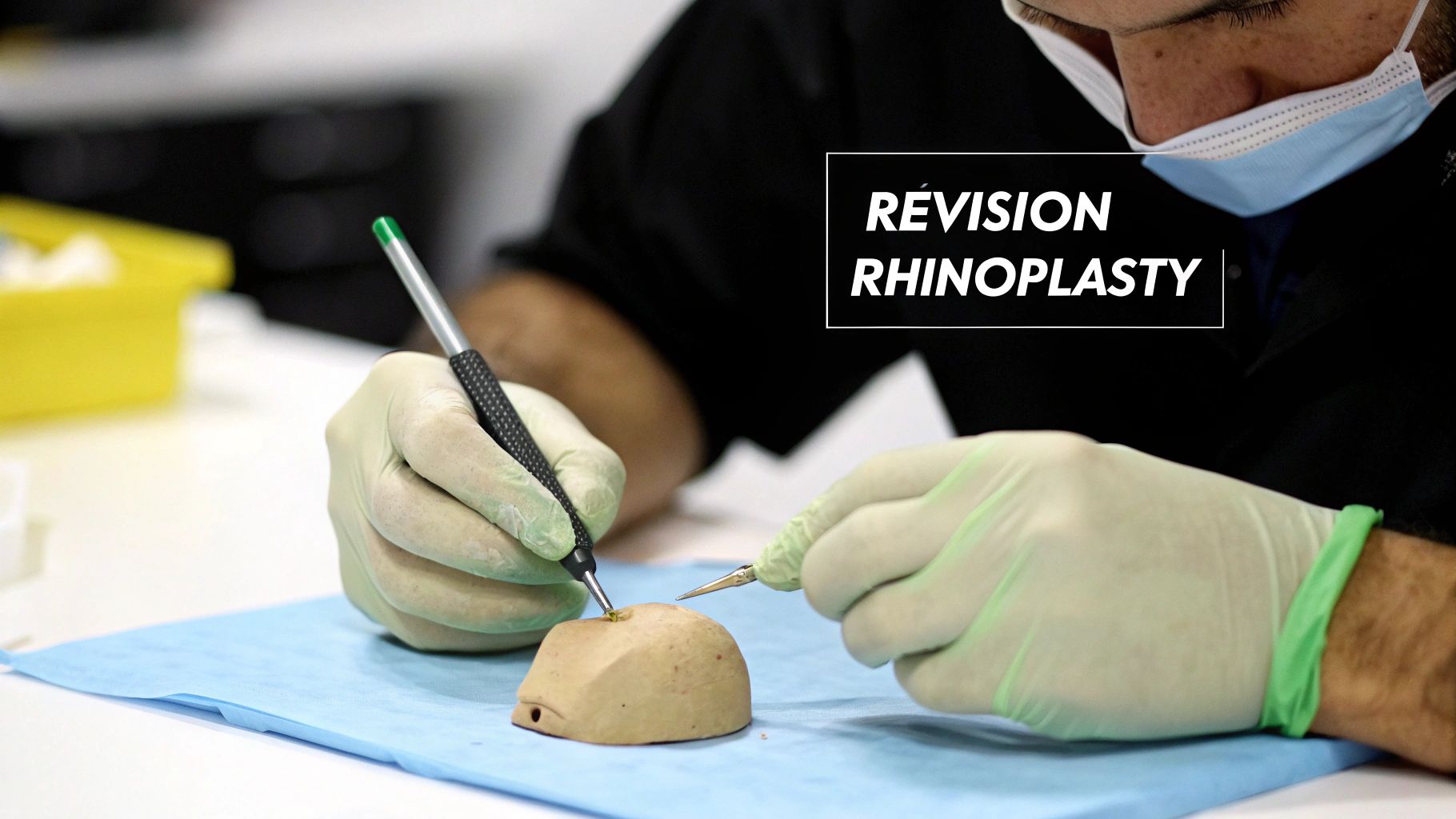
When the outcome of your first rhinoplasty doesn’t quite hit the mark, figuring out the next step can feel overwhelming. This is where revision rhinoplasty, sometimes called secondary rhinoplasty, comes in. It’s a highly specialized surgery performed to correct or fine-tune the results of that initial procedure.
Think of it this way: a primary rhinoplasty is like a sculptor working with a fresh block of clay. A revision is like a master restorer carefully enhancing a valuable sculpture that has already been altered. The goal isn't to start from scratch but to improve upon the existing work with incredible precision and skill.
Patients usually seek this corrective journey for two main reasons:
Grasping what revision rhinoplasty surgery is means understanding why it's so much more challenging than a first-time procedure. The surgeon isn’t starting with a clean slate. They have to carefully navigate internal scar tissue from the first operation, which can hide anatomical landmarks and make delicate adjustments much trickier.
On top of that, the original surgery may have removed too much cartilage, weakening the nasal structure and leaving less material to work with. This is precisely why a revision demands a surgeon with extensive, specific experience in these corrective cases.
The need for this expertise is widespread. A recent international survey revealed that approximately 25% of all rhinoplasty procedures performed by seasoned surgeons are actually revision cases. This statistic alone shows just how common the need for these specialized interventions is.
To give you a clearer picture, let's compare the two procedures side-by-side.
This table highlights the fundamental differences, underscoring why choosing the right surgeon for a revision is so critical.
A successful revision rhinoplasty hinges on a surgeon's ability to diagnose the underlying issues from the first surgery and develop a meticulous plan to correct them. It’s a delicate balance of art and science, requiring both technical skill and a profound understanding of facial aesthetics.
At the end of the day, the goal of this procedure is to deliver the outcome you were hoping for from the very beginning. This might mean refining a nasal tip that doesn't look right, straightening a crooked bridge, or, most importantly, restoring clear and easy breathing.
Patience is key. Surgeons almost always recommend waiting at least a year after your initial surgery before even considering a revision. This waiting period is non-negotiable; it gives the nose time to fully heal so the final, settled results of the first surgery are clear.
By understanding the full rhinoplasty before and after journey, patients can form realistic expectations for both the healing timeline and what a corrective procedure can truly achieve.
Deciding to go through with a second nose surgery is a major step, and it's one that people rarely take lightly. It usually comes after months, or even years, of hoping things will settle just right. But when they don't, patients start looking for solutions—not just for tiny imperfections, but for results that genuinely affect how they feel about themselves or even how they breathe.
Most reasons for a revision fall into two main buckets: either the look just isn't right, or a new breathing problem has popped up. Let’s break down what that really means.
This is, by far, the most common reason people come back for a revision. You wait patiently for a full year, letting all the swelling go down, only to look in the mirror and see a nose that wasn't what you and your surgeon talked about.
The problems can be subtle, or they can be frustratingly obvious. It usually comes down to issues with the nose's overall shape, its balance with the rest of your face, or a lack of symmetry.
Think about a patient like 'Sarah.' Her main goal was to refine a tip she felt was too round. But a year after her surgery, the area just above the tip became swollen and full, creating what surgeons call a "pollybeak deformity." Instead of feeling better, she was more self-conscious than before. It wasn't just a minor flaw; it was a brand-new problem.
The emotional weight of a disappointing result is huge. You invest so much time, money, and hope into the process, and feeling let down can be incredibly frustrating.
Many people forget that rhinoplasty isn't just about looks; it can also be a life-changer for breathing. But what happens when the surgery makes it worse? It's not uncommon for a primary rhinoplasty to unintentionally weaken the internal structures of the nose, leading to brand-new breathing issues.
Take 'David,' for instance. He had surgery to fix a deviated septum and hopefully breathe easier. While his nose looked straighter, he suddenly found himself struggling for air, especially at the gym. It turned out he had nasal valve collapse—the cartilage in his nostrils was now too weak to support them when he inhaled, causing them to narrow.
Some of the most common functional complaints include:
These aren't minor annoyances. Poor breathing can ruin your sleep, make exercise feel impossible, and drag down your overall quality of life. In these cases, a revision surgery becomes a medical necessity.
With primary rhinoplasties on the rise globally, it’s no surprise that more people are also seeking corrective procedures. The United States, Brazil, and Japan lead the way, with the U.S. alone accounting for over 6 million aesthetic procedures each year—a number that includes a growing share of revisions. You can dive deeper into these worldwide statistics by reading the full 2024 report on aesthetic procedures from ISAPS.
In the end, whether the problem is the face staring back from the mirror or the struggle to take a full breath, the reasons for seeking a second nose surgery are completely valid. Pinpointing exactly what went wrong is the crucial first step toward finding the right surgeon to help you finally get the result you’ve been hoping for.
Making the decision to go through with a second nose surgery is a big deal, and frankly, it’s not the right move for everyone. Surgeons have a pretty specific checklist they run through to make sure the procedure will be safe and, just as importantly, successful. Knowing what they’re looking for will help you walk into a consultation feeling prepared and confident about whether this is the best path forward.
First things first: you have to be in good overall health. A revision rhinoplasty is a serious operation, and your body needs to be up to the task of handling anesthesia and healing well. Things like uncontrolled diabetes or major heart issues can introduce serious risks, so they’re often a no-go.
Just as critical is the condition of your nose. Almost any surgeon you meet will insist on waiting at least one full year after your first surgery. This isn't them being difficult; it's a non-negotiable healing period. Over those 12 months, the last bits of swelling finally disappear and the tissues inside your nose soften up, showing the true, final shape from the first operation.
This might be the most important part of the entire equation: you absolutely must have realistic expectations. It's a point surgeons will circle back to again and again because it's directly tied to how happy you'll be with the result. A revision can make a world of difference, but it can’t perform miracles.
I like to think of it this way: a surgeon is a sculptor, not a magician. They can’t turn a pear into a peach. For instance, if you have naturally thick skin, they can certainly refine the shape of your nose, but they can't magically give you the razor-sharp tip you might see on someone with thin skin. The whole point is to create the best possible version of your nose—one that looks natural and fits your face perfectly.
A great outcome always starts with a shared vision between you and your surgeon, one that’s firmly rooted in what’s actually possible on the operating table.
A good candidate gets this. You’re looking for meaningful improvement, not some unattainable idea of perfection. You can point to what you don’t like about your nose and are ready to hear the surgeon’s honest, expert take on what can realistically be achieved.
When you sit down for that initial chat, your surgeon is going to be sizing up a few key things to see if a complex revision is a good fit for you.
Here’s a quick rundown of what’s on their mind:
On the flip side, some things can make you a poor candidate for revision surgery. It’s much better to know this upfront.
This might not be the right procedure for you if you:
In the end, figuring out if you’re a candidate is a team effort. It takes your honest self-reflection and a surgeon’s experienced, professional eye.
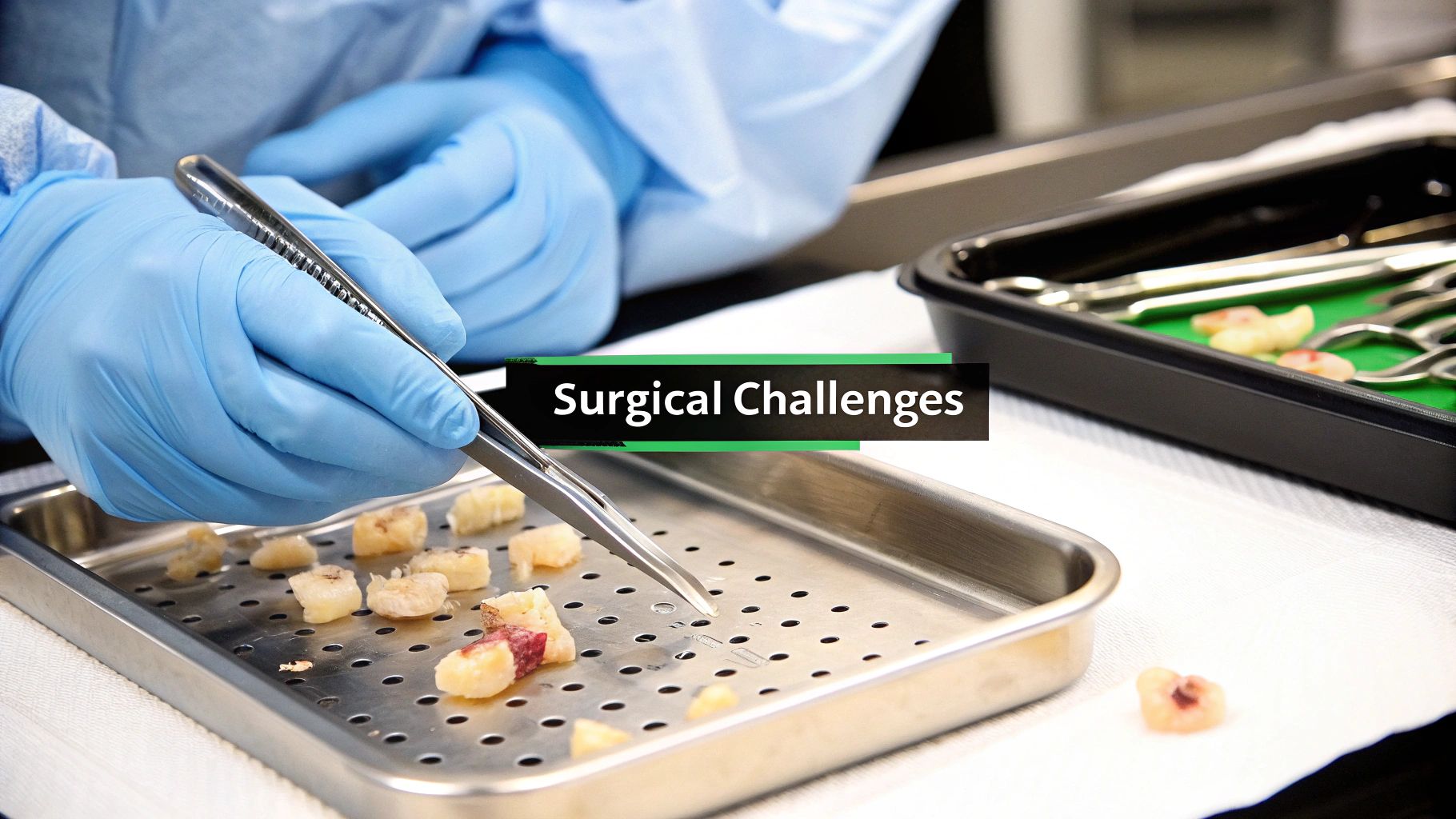
To really grasp what revision rhinoplasty is, you have to appreciate its incredible complexity. This isn't just a simple "do-over." It's a far more demanding operation that throws a unique set of obstacles at even the most seasoned facial plastic surgeon.
Here’s a good way to think about it: a primary rhinoplasty is like building a house from the ground up. You have a clean blueprint and fresh, untouched materials. Revision rhinoplasty, on the other hand, is like renovating a historic home that’s already had some questionable work done. You first have to figure out what the last person did, navigate their mistakes, and rebuild using a mix of original and new materials—all without compromising the building's integrity. That’s the world of corrective nose surgery.
The biggest hurdle in almost any revision procedure is internal scar tissue, or fibrosis. After your first surgery, your body did its job and healed by forming scar tissue. The problem is, this tissue is tough, unpredictable, and makes the surgical field a minefield.
This scar tissue basically drapes a veil over the delicate cartilage and bone I need to see. It makes it incredibly difficult to identify the natural anatomical landmarks that guide precise adjustments. Carefully dissecting through all that fibrosis demands a huge amount of skill and patience. One wrong move could easily damage the already weakened structures underneath.
Navigating a landscape of scar tissue is arguably the most difficult aspect of revision rhinoplasty. It alters the normal surgical planes, increases bleeding, and can make achieving a smooth, natural contour much more challenging.
The presence of scar tissue also means swelling after a revision is often more significant and lasts longer than it did the first time around. This is something every patient needs to understand when setting expectations for their recovery.
Another major challenge is having to work with a weakened or depleted nasal structure. During the initial surgery, cartilage and bone were likely removed or reshaped. In some cases, far too much was taken, leaving the nose without enough support to hold its shape.
It's like starting that home renovation only to find out the previous builder removed a few critical support beams. The nose may now lack the internal framework it needs to look right and, more importantly, to function properly for breathing. My first job is often to reconstruct this foundation before I can even think about making any aesthetic refinements.
This structural deficit is precisely why cartilage grafts are so common in revision cases.
The frequent need for grafting really underscores the reconstructive nature of this surgery. Data from fellow surgeons backs this up, showing that in about 60% of revision cases, autologous costal (rib) cartilage grafts are the top choice for rebuilding the nose's foundation. You can read more about these surgical preferences and techniques in recent studies.
Finally, a surgeon performing a revision isn't dealing with a "textbook" nose. The anatomy has been permanently changed by the first operation. The skin might be thinner in some areas and thickened with scar tissue in others. The cartilage that’s left could be weak, twisted, or sitting in an unnatural position.
Every single revision case is a unique puzzle. The surgeon's first job is to diagnose exactly what went wrong in the primary procedure and then create a completely custom plan to fix it using the altered tissues that are left. This requires a deep, nuanced understanding of both nasal aesthetics and function, which makes your choice of surgeon absolutely critical for a successful outcome.
Once you’ve decided to go ahead with a second nose surgery, your attention needs to turn to the one thing that will make or break your outcome: your surgeon. This isn’t a simple procedure, and the person holding the instruments needs to have a truly specialized skill set. Honestly, choosing the right professional is the most critical decision you'll make in this entire process.
It’s like needing a complex heart valve repair. You wouldn’t just go to a general doctor; you'd find a cardiac surgeon who has done that exact operation hundreds of times. The same logic applies here. A surgeon who specializes in revision rhinoplasty has a depth of knowledge and experience that's on a completely different level from even a very good primary rhinoplasty surgeon.
Finding the right surgeon takes a bit of detective work. You’re looking for a very specific blend of credentials, hands-on experience, and a real artistic eye. Keep in mind, a surgeon who does beautiful work on a first-time nose job might not be equipped to handle the scar tissue and structural challenges of a nose that’s already been operated on.
Use this checklist to help narrow down your options:
Think of choosing your surgeon as the biggest investment you’ll make in your final result. Their skill in diagnosing what went wrong the first time and creating a precise plan to fix it is everything.
The consultation is your chance to interview your potential surgeon. Walk in prepared with a list of questions that get straight to the point about their expertise. This isn't the time to be timid; you're putting your face and your confidence in their hands.
Here are a few questions you should absolutely ask:
Asking direct questions like these helps you get a feel for their confidence and level of experience. A truly skilled revision specialist will answer you directly, explain their reasoning, and give you a realistic picture of what’s possible.
For a deeper dive, our guide on how to choose a surgeon provides more tips for making this crucial decision. Taking your time here is the single best thing you can do for yourself.
The thought of a second nose surgery can be daunting. Let's be honest, you've been through this once before. But breaking the process down, step by step, can take the anxiety out of the equation and help you feel in control. Think of it as a roadmap—from the very first conversation to the final result, knowing what's around each corner makes all the difference.
Each phase is there for a reason, designed to make sure everything goes as smoothly and safely as possible.
It all starts with the consultation. This is so much more than a quick meet-and-greet; it’s your chance to see if you and the surgeon are on the same page. You're not just choosing a doctor; you're choosing a partner for this highly personal process.
Come prepared to talk openly. What, specifically, are you unhappy with from your first surgery? What does your ideal outcome look like? Bringing photos can be incredibly helpful. Don't be shy about asking tough questions, especially about the surgeon's direct experience with cases as complex as yours. A great consultation is a real conversation that builds trust and sets a clear, achievable goal.
Once you’ve found the right surgeon and set a date, the focus shifts to getting you ready for the procedure. Your surgeon will give you a specific set of instructions to follow, all aimed at optimizing your health for surgery and recovery.
This usually involves a few key things:
This infographic highlights the most critical part of your preparation: choosing the right expert.
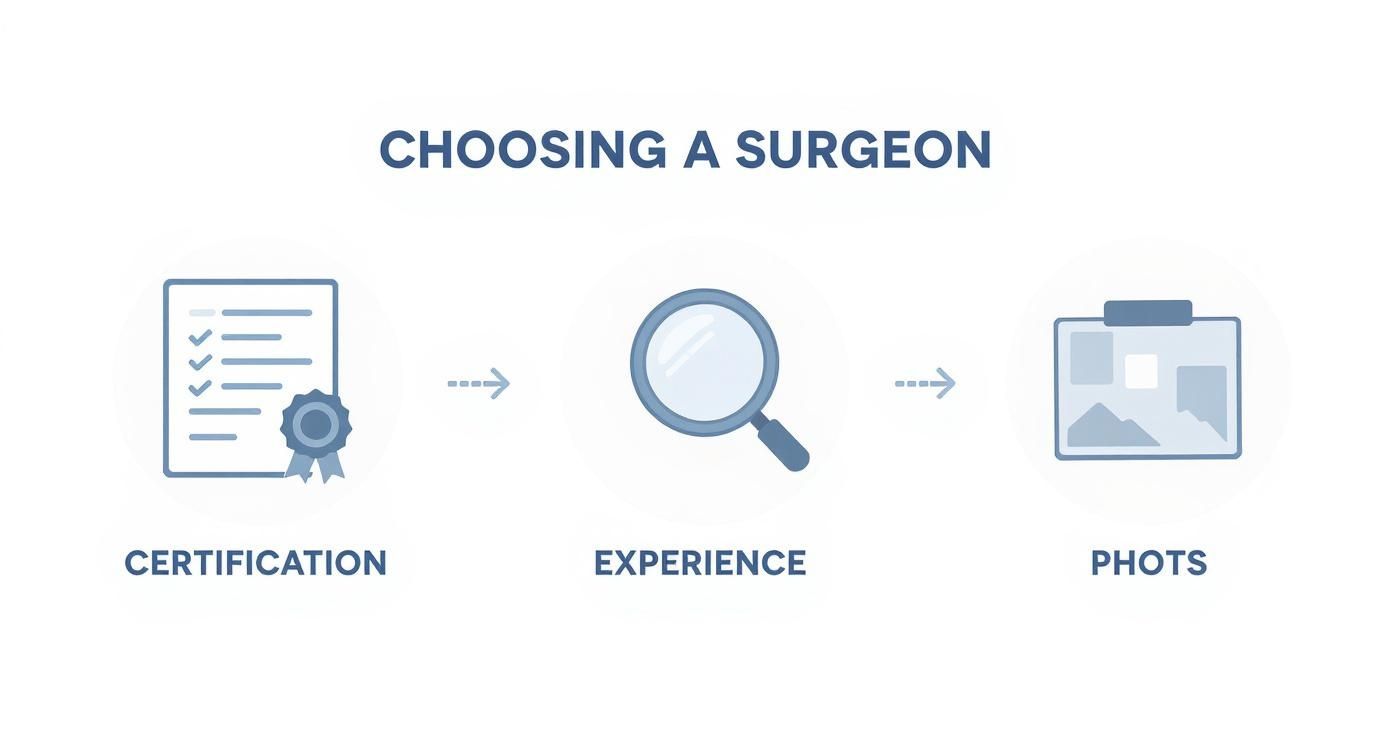
Starting with a surgeon who is qualified, experienced, and transparent is the foundation for a successful outcome.
When surgery day arrives, the team’s entire focus is on you. You'll meet with your surgeon and the anesthesiologist one last time to go over the plan and answer any last-minute questions. The procedure is almost always done under general anesthesia, so you’ll be comfortably asleep the whole time.
Whether your surgeon uses an open approach (with a tiny incision on the strip of skin between the nostrils) or a closed one (with all incisions hidden inside) will have already been decided. Most revision cases require an open rhinoplasty, as it gives the surgeon the best possible view to work through scar tissue and carefully place structural grafts.
The day of surgery is the culmination of all the planning and preparation. Your job is to relax and trust the team that has created a meticulous surgical plan just for you.
Patience is the name of the game when it comes to recovery. It’s similar to your first go-around, but because revision work is often more complex, you can expect the swelling to be a bit more significant and stick around longer.
It’s completely normal to have questions swirling around after learning about revision rhinoplasty. Thinking about a second surgery brings up very practical concerns—everything from timing and cost to what the experience will actually be like. Let's tackle some of the most common questions head-on.
This is a big one, and the answer is pretty consistent across the board: you need to wait at least one full year after your first surgery. This isn't just a suggestion; it's a non-negotiable part of the process for your own safety and for the best possible outcome.
Think of it this way: your nose needs time to fully heal and "settle." Over that first year, the last of the swelling finally goes down and the scar tissue inside softens up. Only then can you and your surgeon see the true, final shape from the initial procedure. Trying to operate any sooner is like building on a foundation that's still wet—the structure is unstable, and the results are completely unpredictable.
Yes, you can expect a revision surgery to cost more than a primary rhinoplasty. This isn't arbitrary—the higher price tag is a direct reflection of just how much more complex and demanding the procedure is.
So, what drives the cost up?
When you invest in a revision, you're not just paying for a procedure. You're paying for the advanced expertise of a specialist who lives and breathes these complex corrective cases. Their skill is the single most important factor in getting the result you want.
Like any surgery, revision rhinoplasty comes with standard risks such as infection, bleeding, or a reaction to anesthesia. But because this is a more intricate operation, it has its own unique set of potential complications.
These can include breathing difficulties that don't resolve, being unhappy with the final aesthetic look, or lingering numbness. There's also the chance that cartilage grafts could warp or be absorbed by the body over time. The absolute best thing you can do to minimize these risks is to choose a board-certified facial plastic surgeon who has a long, proven track record with revision rhinoplasty. Their experience is your greatest asset.
At Cape Cod Plastic Surgery, Dr. Fater and his team are dedicated to providing expert guidance and exceptional results. If you are considering a revision procedure, we invite you to schedule a consultation to discuss your goals in a supportive and professional environment. Learn more about your options at https://ccplasticsurgery.com.

November 13, 2025
what is revision rhinoplasty surgery? Learn who qualifies, what to expect during recovery, and tips for choosing a skilled, trusted surgeon.
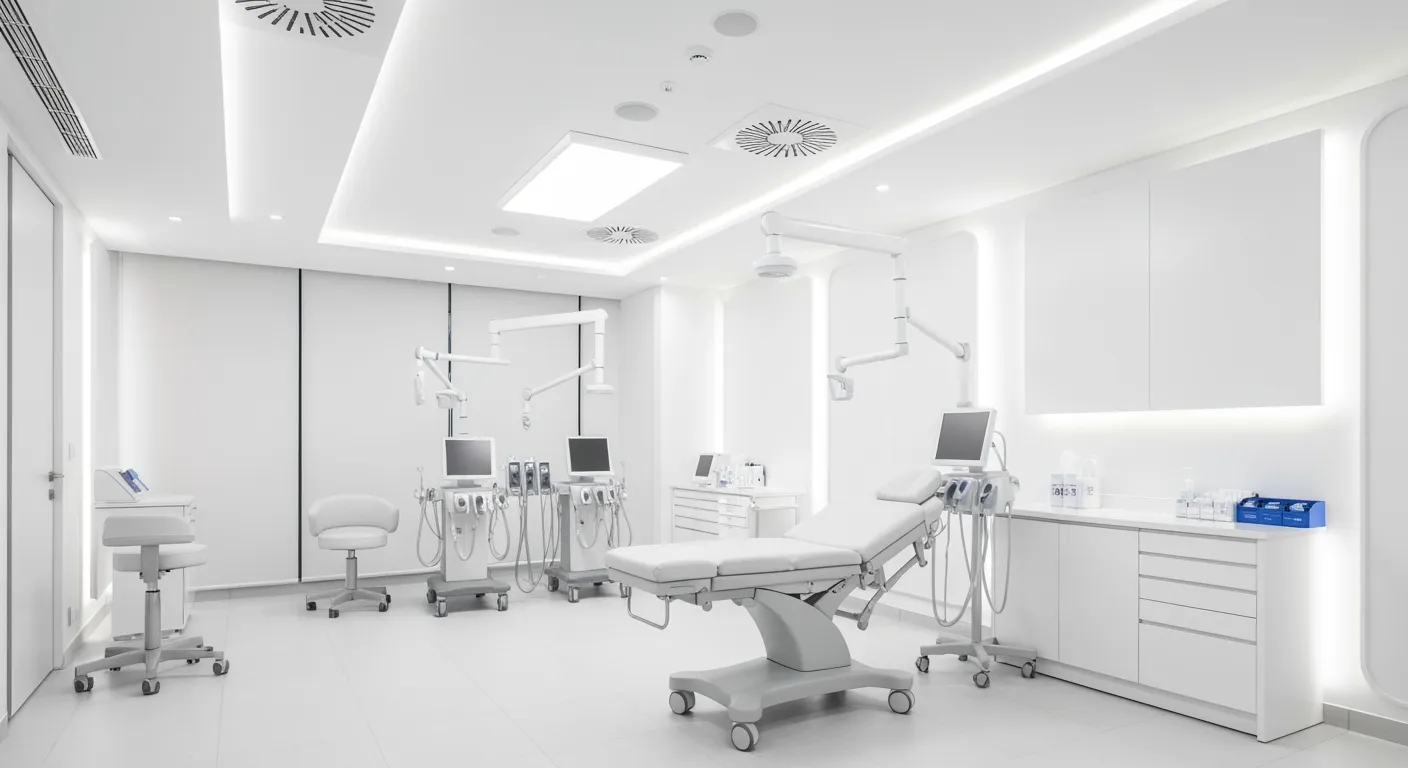
November 13, 2025
Insights Into Plastic Surgery: Expert Answers and Essential Guidance

November 13, 2025
Navigating Your Breast Surgery Options: Key Factors to Weigh